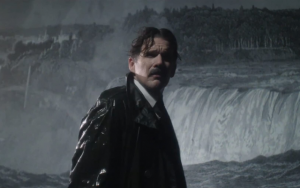TESLA: 3 ½ STARS. “as idiosyncratic as the man it portrays.”
 Serbian-American inventor Nikola Tesla (Ethan Hawke) was a man with an eye to the future. He’s best known for best known for his innovations in the transmission and application of electric power but his restless mind was always engaged, burning hot with new ideas.
Serbian-American inventor Nikola Tesla (Ethan Hawke) was a man with an eye to the future. He’s best known for best known for his innovations in the transmission and application of electric power but his restless mind was always engaged, burning hot with new ideas.
If we are to believe “Tesla,” a fanciful postmodern biopic starring Ethan Hawke, now on VOD, he had the ability to project himself into the future, predicting what was to come, including x-rays and even the Tears for Fears hit “Everybody Wants to Rule the World.”
A knowing mix of fact and fiction, “Tesla” is narrated by Anne Morgan (Eve Hewson), daughter of financier and banker J.P. Morgan, who says after one flight of fancy, while scrolling through her MacBook Pro, “This is pretty surely not how it happened.” It’s a self-aware story, filled with authenticity but also anachronisms to paint a portrait of a man out of time.
Detailing the period in Tesla’s life from his early work with Thomas Edison (Kyle MacLachlan) at the Edison Machine Works on New York’s Lower East Side through to his encounters with the leading lights of the era, J.P. Morgan (Donnie Keshawarz), renowned French actress Sarah Bernhardt (Rebecca Dayan) and entrepreneur George Westinghouse (Jim Gaffigan). It’s a heady time that sees Tesla dream big and fail bigger, ultimately reduced to begging Morgan for money before dying penniless and alone at the age of 86 in Room 3327 of the Hotel New Yorker.
“Tesla” is not a tale for history buffs. Edison is seen with an iPhone and a gaggle of heiresses listen to electro-pop but these anachronisms aren’t for effect, like spotting the wristwatch on Matthew Broderick’s arm in the 1800s set “Glory” or the iPod Touch in “The Hurt Locker,” three years before the mobile devices were in stores, they’re meant to add to the poetry of the telling, as metaphors for the forward-thinking inventor. “Maybe the world is a dream,” says Anne Morgan, “that Tesla dreamed first.”
Tesla, the man, aimed high, hoping his inventions would set people free to enjoy pursuits of the mind. “That motor will do the work of the world,” he says in the film. “It will set men free.” Similarly, the movie aims high, and while it takes chances—see the above mentioned “Everybody Wants to Rule the World” scene—it is as idiosyncratic as the man it portrays.
